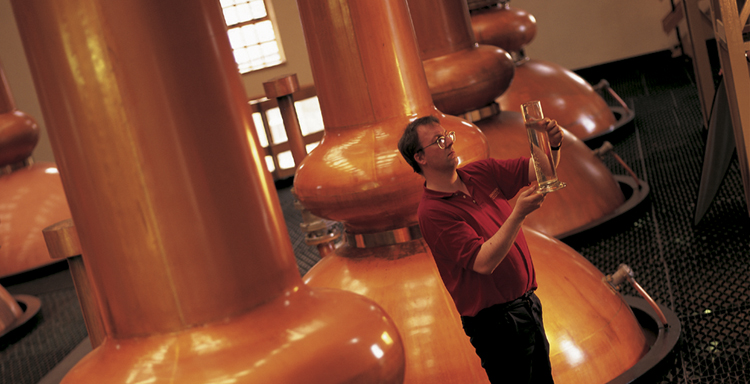When global brand giant LVMH bought Glenmorangie plc off the stockmarket for GBP300m, they picked up not only the biggest selling malt in Scotland, and the fourth biggest in the world, they also acquired the lesser known Speyside Glen Moray, and the rightly famous Islay malt, Ardbeg.
Glen Moray
Glen Moray is on the outskirts of Elgin, near the River Lossie and 4 miles from the sea. Glenmorangie is to the North West, perhaps 30 miles as the crow flies over the great mouth of the River Ness, the Moray Firth. Islay, and Ardbeg, are the width of Scotland away, and the characteristics of the whiskies match their geographical separation.
Glen Moray, while respected, has never had the glamour of its house sisters, or its Speyside neighbours. A ladies’ whisky. Grassy with a hint of grape juice. Colours vary from very pale yellow, to old gold, based very much on age in the barrel. A vinous note can be detected, and the distillery has built on this by following the fashion (begun by Glenmorangie) of maturing their whiskies in wine barrels. Glen Moray pioneered the use of white wine barrels, and their whiskies do indeed deliver hints of fruit scent together with wood and nut overtones. The building was once a brewery, and there seems no doubt that it was the quality of the soft peaty water that attracted the first brewers to the area.
Glenmorangie
Glenmorangie is one of the great names in malt. Easily outselling the opposition in whisky’s homeland for 47 years, it has a huge following worldwide, and for my money is the best of the big names. Creamy and smooth with great character and balance, all their whiskies, and they make a great many, deliver value and pleasure in equal measure. Not all whiskies are to every drinker’s taste. Some swear by Tomintoul – which I loathe. Others, like me, very reluctantly stray from the great peaty and seaweedy giants of Islay: Ardbeg, Laphroig and Lagavulin. I am delighted to say that some whisky people don’t like these particular whiskies. But no-one in my experience has ever had anything but praise for Glenmorangie.
That isn’t to say that Glenmorangie is a happy medium. No, it has a character of its own, and actively seeks controversy, in the eyes of some, by pursuing its innovative policy of maturing its whiskies in different wood finishes. They go to extraordinary lengths. For example, the virgin American Oak vattings. They own oak trees in the Ozark mountains, season the timber by slow drying in air, and then lend the ensuing barrels to Jack Daniels for 4 or 5 years. Only then are the barrels brought to Scotland and filled with single malt.
Their madeira, port, burgundy and sherry finishes have their afficionados, although whisky conservatives growl into their drams at such tinkering, there is no question that it is successful, and it was this success that caught the eye of LVMH.
They have recently announced a major re-branding – pushing Glenmorangie into the luxury arena, and it remains to be seen what this will do to the variety of whiskies produced. In the short to medium term there is nothing to fear – whisky bought this year is at least 10 years old, so any change in distilling policy will only be seen a decade from now. The re-branding may be no more than a cosmetic exercise to make the product more acceptable at higher prices in new markets. If that is all it is, fill your boots now, and tuck some away while it is still cheap.
Ardbeg
LVMH seem to be leaving my old favourite Ardbeg alone for the time being, and all lovers of big strong hairy whiskies must hope that they continue to do so. Drawing on the passionate support of their 60-year-old fan club, The Ardbeg Committee, they continue to produce whiskies that are pungent, peaty, and reeking of iodine and the seashore, yet with subtle smoothness and warming power.
The distillery went through a time of mixed fortune, with several periods of being moth-balled, but since its last re-opening in 1997, has gone from strength to strength. Many bottlings are done at cask strength and non-chillfiltered, and despite the almost violent initial character of the whisky, with its glorious richness of taste and smell, the whisky is seductively smooth, and seems to do particularly well if kept on the wood for great periods of time. The 23 years in sherry cask Ardbeggeddon is sublime (and aptly named), while 10 years for most whiskies is plenty.
